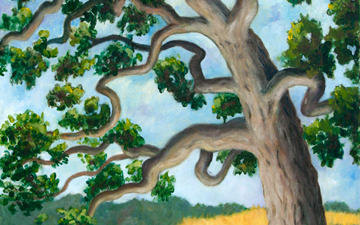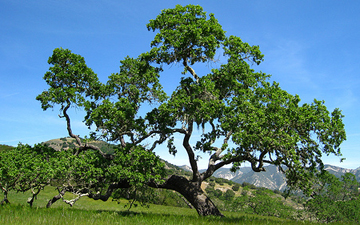Quercus lobata, commonly called the valley oak, grows into the largest of North American oaks. It is endemic to California, growing in the hot interior valleys and foothills. Mature specimens may attain an age of up to 600 years. This deciduous oak requires year-round access to groundwater.
Its thick, ridged bark is characteristic and evokes alligator hide. The Valley oak’s felt-like deeply lobed leaves assist in rapid identification.
The sturdy trunk of the Valley oak may exceed two to three meters in diameter and its towering stature may surpass 30 meters in height. The branches have an irregular, spreading and arching appearance that produce a profound leafless silhouette in the clear winter sky. During Autumn leaves turn a yellow to light orange color but become brown during mid to late fall. In advancing age the branches actually assume a drooping characteristic. Its pewter colored rippled bark adds to the attractive aesthetic of this species.
(From Wikipedia, May 11th, 2010)
– – –
Mature trees of Quercus lobata are among the largest oaks of the United States. The species hybridizes with numerous other species, but the hybrids are not common in most parts of its range. On Santa Cruz and Santa Catalina islands, however, occur extensive and relatively stable populations that show intermediate characteristics with Q . pacifica (see treatment). The hybrids have been given the name Q . × macdonaldii , and they differ from Q . lobata in the following: leaf sinuses reaching less than half the distance to the midrib; leaves usually smaller, the lobes often more acute and brighter green; and acorns smaller, with more acute apices.
(From EOL via efloras.org)





